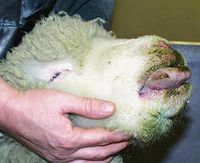Bluetongue Virus (BTV): Difference between revisions
(Created page with 'Bluetongue Virus (BTV) {{Curated}} {{Viral Biorealm Family}} [[Image:Bluetongue.jpg|thumb|200px|right|Clinical signs of bluetongue infection in ruminants such as sheep include sw…') |
No edit summary |
||
| Line 17: | Line 17: | ||
==Description and Significance== | ==Description and Significance== | ||
<br> | <br> | ||
Bluetongue Virus (BTV) is a pathogenic virus that causes serious disease in livestock. BTV was first observed in Africa in the late 18th century, but has since been observed in Australia, the United States, Africa, the Middle East, Asia, and Europe. There are 24 distinct serotypes of BTV. BTV causes Bluetongue disease in ruminant species, such as sheep, goats, deer, and cattle, although clinical signs of infection are almost solely restricted to sheep [http://www.bluetonguevirus.org/about-bluetongue]. | |||
<br><br> | |||
The incubation period for BTV is 5-20 days. BTV infection first manifests itself with the onset of a high fever that may last several days. The virus mainly affects small blood vessels, causing hemorrhaging, hyperemia, and edema in the tissue of the lips, mouth, nasal linings, and eyelids. Swelling of the lips and tongue, accompanied by viral destruction of host blood vessels decreases the amount of oxygen that reaches the tongue tissue. Reduced oxygen delivery causes cyanosis, or the blue appearance of the tongue. However, cyanosis is usually confined to the minority of Bluetongue cases [http://www.aphis.usda.gov/animal_health/animal_diseases/bluetongue/]. | |||
<br> | |||
[[Image:Bluetongue pic 2.jpg|thumb|200px|right|Swelling of the lips and tongue upon BTV infection can lead to frothing. [http://www.google.com/imgres?imgurl=http://3.bp.blogspot.com/_XkyaXZ1rRaU/RvWE8LMva-I/AAAAAAAAAlE/SMpZ7JGoVJI/s400/Bluetongue%2Bdrooling%2Bsheep.jpg&imgrefurl=http://tomjacksononline.blogspot.com/2007/09/bluetongue-in-suffolk.html&usg=__2OfM8VCkusoKlLbCWK9YQmIM6AQ=&h=273&w=325&sz=22&hl=en&start=0&zoom=1&tbnid=mgZDi2PVW6jg8M:&tbnh=146&tbnw=174&prev=/images%3Fq%3Dblue%2Btongue%2Bdrooling%26um%3D1%26hl%3Den%26sa%3DX%26biw%3D1280%26bih%3D588%26tbs%3Disch:1&um=1&itbs=1&iact=hc&vpx=146&vpy=77&dur=57&hovh=206&hovw=245&tx=128&ty=89&ei=VVqJTMalLpWfnwfQvaG1Dg&oei=VVqJTMalLpWfnwfQvaG1Dg&esq=1&page=1&ndsp=19&ved=1t:429,r:0,s:0].]] | |||
<br> | |||
The mortality rate of especially susceptible breeds of sheep can be as high as 70%, as a result of secondary bacterial infections. Furthermore, the high fever experienced by infected sheep can lead to wool breaks, decreasing productivity [2]. Some species, primarily cattle and goats, are asymptomatic upon BTV infection, but their productivity as livestock can be significantly reduced, with milk yields dropping nearly 40% [http://www.microbiologybytes.com/blog/2007/09/28/bluetongue-virus/]. BTV has been considered a possible bioweapon because of the difficulty associated with controlling and eliminating the disease, as well as the significant economic loss that would result from widespread infection [http://www.cidrap.umn.edu/cidrap/content/biosecurity/ag-biosec/anim-disease/blueto.html#_Treatment]. | |||
<br> | |||
<br> | |||
There are no treatment options for BTV. Immunization has proved the most effective way to prevent bluetongue outbreaks in endemic regions. In southern Africa and other affected regions, a vaccine comprised of 5 attenuated BTV serotypes is widely used. In the United States, a vaccine containing a modified live version of a single serotype is utilized [http://www.merckvetmanual.com/mvm/index.jsp?cfile=htm/bc/54700.htm&word=bluetongue]. | |||
<br> | |||
==Genome Structure== | ==Genome Structure== | ||
Revision as of 22:22, 9 September 2010
Bluetongue Virus (BTV)
A Viral Biorealm page on the family Bluetongue Virus (BTV)

Baltimore Classification
Group III: Double-Stranded RNA Viruses
Higher order categories
Order: Unassigned
Family: Reoviridae
Subfamily: Sedoreovirinae
Genus: Orbivirus
Description and Significance
Bluetongue Virus (BTV) is a pathogenic virus that causes serious disease in livestock. BTV was first observed in Africa in the late 18th century, but has since been observed in Australia, the United States, Africa, the Middle East, Asia, and Europe. There are 24 distinct serotypes of BTV. BTV causes Bluetongue disease in ruminant species, such as sheep, goats, deer, and cattle, although clinical signs of infection are almost solely restricted to sheep [3].
The incubation period for BTV is 5-20 days. BTV infection first manifests itself with the onset of a high fever that may last several days. The virus mainly affects small blood vessels, causing hemorrhaging, hyperemia, and edema in the tissue of the lips, mouth, nasal linings, and eyelids. Swelling of the lips and tongue, accompanied by viral destruction of host blood vessels decreases the amount of oxygen that reaches the tongue tissue. Reduced oxygen delivery causes cyanosis, or the blue appearance of the tongue. However, cyanosis is usually confined to the minority of Bluetongue cases [4].

The mortality rate of especially susceptible breeds of sheep can be as high as 70%, as a result of secondary bacterial infections. Furthermore, the high fever experienced by infected sheep can lead to wool breaks, decreasing productivity [2]. Some species, primarily cattle and goats, are asymptomatic upon BTV infection, but their productivity as livestock can be significantly reduced, with milk yields dropping nearly 40% [5]. BTV has been considered a possible bioweapon because of the difficulty associated with controlling and eliminating the disease, as well as the significant economic loss that would result from widespread infection [6].
There are no treatment options for BTV. Immunization has proved the most effective way to prevent bluetongue outbreaks in endemic regions. In southern Africa and other affected regions, a vaccine comprised of 5 attenuated BTV serotypes is widely used. In the United States, a vaccine containing a modified live version of a single serotype is utilized [7].
Genome Structure
Virion Structure of BTV
Reproductive Cycle of BTV in a Host Cell
Viral Ecology & Pathology
References
Example:
Weir, Jerry P. " Genomic Organization and Evolution of the Human Herpesviruses." Virus Genes 16.1 (1998): 85-93.
Page authored for BIOL 375 Virology, September 2010
